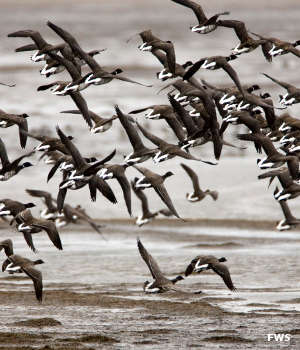Becharof National Wildlife Refuge

Becharof National Wildlife Refuge

Red-faced cormorants
Becharof National Wildlife Refuge started out as Becharof National Monument. The presidential proclamation was signed by President Jimmy Carter on December 1, 1978 and the property was established on December 2, 1990 by the Alaska National Interest Land Conservation Act. The US Fish and Wildlife Service took charge of the property in 1993.
The 1.2 million acres of Becharof National Wildlife Refuge lie at the eastern end of the Alaska Peninsula. This whole area of Alaska was heavily affected by the Exxon Valdez oil spill in 11009. Since that time, biologists have been regularly conducting extensive surveys in the area to see just how well the various native marine and avian species are recovering.
The centerpiece of Becharof NWR is Becharof Lake, 35 miles long, 15 miles wide, up to 600 feet deep and covering some 300,000 acres. Becharof Lake is the largest lake in the National Wildlife Refuge system, the second largest lake in Alaska. The lake is a massive producer of sockeye salmon, providing Bristol Bay with an estimated 6 million adult salmon per year. Because of all that salmon, this is also where you'll find the largest concentration of brown bears in Alaska. You'll also find moose, fox, wolverine, beaver, river otter and members of the Northern Alaska Peninsula Caribou Herd here.
To the southwest of Becharof is the Alaska Peninsula National Wildlife Refuge. To the northeast is Katmai National Park and Preserve.

Dry Bay, Becharof Wilderness

The Becharof Wilderness is a 500,000-acre area in the northeast section of Becharof National Wildlife Refuge, enclosing some of the volcanic structures and many of the bird cliffs rising above the ocean waves of Shelikof Strait and above Becharof Lake.
This is an area of high mountains rising abruptly from the ocean's edge with deep fjords, broad valleys, glacial lakes and lots of tundra. Along the ocean's shore you'll find colonies of sea lion, harbor seal and sea otter with whales hanging out offshore.
This undisturbed habitat is called home by thousands of ducks, swans and geese. There are significant populations of American green-winged teal, common goldeneye, common merganser, northern pintail, northern shoveler, American and Eurasian wigeon, Canada goose, tundra swan, greater scaup, greater white-fronted goose, mallard, black scooter, long-tailed duck and red-breasted merganser. Winter finds red-breasted merganser, willow ptarmigan, gray jay, common goldeneye, bald eagle, glaucous-winged gull, common raven, black-billed magpie, northern shrike, chickadee and common redpoll in the area.

Puale Bird Cliffs, Becharof Wilderness

Salmon fighting their way upstream to spawn

Ugashik-Peulik Volcano rising to the south of Becharof Lake

Ugashik Caldera, adjacent to Peulik volcano

Photos and map of Becharof NWR courtesy of the US Fish & Wildlife Service
Photo of Ugashik Caldera courtesy of ME Yount, USGS
Some photos courtesy of the Donna Dewhurst collection, US Fish & Wildlife Service
Lower photo of Mt. Paulik volcano courtesy of R.J. Wilk, US Fish & Wildlife Service